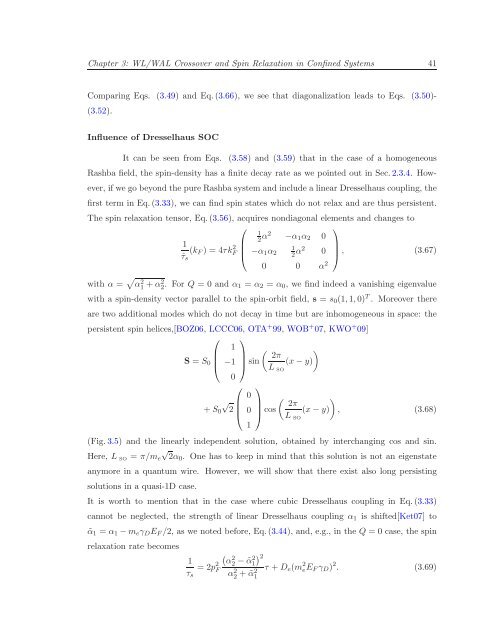Itinerant Spin Dynamics in Structures of ... - Jacobs University
Itinerant Spin Dynamics in Structures of ... - Jacobs University
Itinerant Spin Dynamics in Structures of ... - Jacobs University
Create successful ePaper yourself
Turn your PDF publications into a flip-book with our unique Google optimized e-Paper software.
Chapter 3: WL/WAL Crossover and <strong>Sp<strong>in</strong></strong> Relaxation <strong>in</strong> Conf<strong>in</strong>ed Systems 41<br />
Compar<strong>in</strong>g Eqs. (3.49) and Eq.(3.66), we see that diagonalization leads to Eqs. (3.50)-<br />
(3.52).<br />
Influence <strong>of</strong> Dresselhaus SOC<br />
It can be seen from Eqs. (3.58) and (3.59) that <strong>in</strong> the case <strong>of</strong> a homogeneous<br />
Rashba field, the sp<strong>in</strong>-density has a f<strong>in</strong>ite decay rate as we po<strong>in</strong>ted out <strong>in</strong> Sec.2.3.4. However,<br />
if we go beyond the pureRashba system and <strong>in</strong>clude a l<strong>in</strong>ear Dresselhaus coupl<strong>in</strong>g, the<br />
first term <strong>in</strong> Eq.(3.33), we can f<strong>in</strong>d sp<strong>in</strong> states which do not relax and are thus persistent.<br />
The sp<strong>in</strong> relaxation tensor, Eq.(3.56), acquires nondiagonal elements and changes to<br />
⎛ ⎞<br />
1<br />
2<br />
1<br />
(k F ) = 4τkF<br />
2 α2 −α 1 α 2 0<br />
⎜ 1<br />
ˆτ s<br />
⎝ −α 1 α 2 2 α2 0 ⎟<br />
⎠ , (3.67)<br />
0 0 α 2<br />
with α = √ α 2 1 +α2 2 . For Q = 0 and α 1 = α 2 = α 0 , we f<strong>in</strong>d <strong>in</strong>deed a vanish<strong>in</strong>g eigenvalue<br />
with a sp<strong>in</strong>-density vector parallel to the sp<strong>in</strong>-orbit field, s = s 0 (1,1,0) T . Moreover there<br />
are two additional modes which do not decay <strong>in</strong> time but are <strong>in</strong>homogeneous <strong>in</strong> space: the<br />
persistent sp<strong>in</strong> helices,[BOZ06, LCCC06, OTA + 99, WOB + 07, KWO + 09]<br />
⎛ ⎞<br />
1 ( )<br />
S = S 0<br />
⎜<br />
⎝ −1 ⎟ 2π<br />
⎠ s<strong>in</strong> (x−y)<br />
L SO<br />
0<br />
⎛ ⎞<br />
0 ( )<br />
√ +S 0 2 ⎜<br />
⎝ 0 ⎟ 2π<br />
⎠ cos (x−y) , (3.68)<br />
L SO<br />
1<br />
(Fig.3.5) and the l<strong>in</strong>early <strong>in</strong>dependent solution, obta<strong>in</strong>ed by <strong>in</strong>terchang<strong>in</strong>g cos and s<strong>in</strong>.<br />
Here, L SO = π/m e<br />
√<br />
2α0 . One has to keep <strong>in</strong> m<strong>in</strong>d that this solution is not an eigenstate<br />
anymore <strong>in</strong> a quantum wire. However, we will show that there exist also long persist<strong>in</strong>g<br />
solutions <strong>in</strong> a quasi-1D case.<br />
It is worth to mention that <strong>in</strong> the case where cubic Dresselhaus coupl<strong>in</strong>g <strong>in</strong> Eq.(3.33)<br />
cannot be neglected, the strength <strong>of</strong> l<strong>in</strong>ear Dresselhaus coupl<strong>in</strong>g α 1 is shifted[Ket07] to<br />
˜α 1 = α 1 −m e γ D E F /2, as we noted before, Eq.(3.44), and, e.g., <strong>in</strong> the Q = 0 case, the sp<strong>in</strong><br />
relaxation rate becomes<br />
(<br />
1 α<br />
= 2p 2 2<br />
2 − ˜α 2 2<br />
1)<br />
F<br />
τ s α 2 2 + τ +D e (m 2 eE F γ D ) 2 . (3.69)<br />
˜α2 1
















